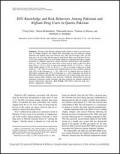Publications - Released in 2003
Situated on the Pakistan-Afghan border, Quetta is home to growing numbers of Afghan refugees. We studied HIV knowledge and risk behaviors among Pakistani and Afghani drug users between July 2001 and November 2001. Of 959 drug users, all were male and the majority used heroin. Most were Pakistani (84.8%), 14.9% were Afghani, and 0.3% were Iranian. Relative to Pakistani drug users, a higher proportion of Afghanis reported no formal education, homelessness, and unemployment (p < .001).
Afghanis were more likely to have used an opiate as their first illicit drug (16% vs. 7%, p < .001), to have ever injected (18.8% vs. 12.3%, p = .04), to report needle sharing (72.2% vs. 48.2%, p = .08), or to report a drug user in their family (p = .08). None of sexually active Afghanis had ever used a condom compared with 5.0% of the Pakistanis (p = .01). Only 4.3% of Afghans had ever heard of HIV/AIDS compared with 18.3% of Pakistanis (p < .001). Extremely low levels of HIV/AIDS awareness and high HIV risk behaviors were evident among drug users in Quetta, among whom Afghanis were especially vulnerable. Interventions to prevent transition to injection, needle exchange, and drug treatment are urgently required to prevent blood-borne infections.






